- Home
- Stephen Hawking
A Brief History of Time Page 2
A Brief History of Time Read online
Page 2
Aristotle, and most of the other Greek philosophers, on the other hand, did not like the idea of a creation because it smacked too much of divine intervention. They believed, therefore, that the human race and the world around it had existed, and would exist, forever. The ancients had already considered the argument about progress described above, and answered it by saying that there had been periodic floods or other disasters that repeatedly set the human race right back to the beginning of civilization.
The questions of whether the universe had a beginning in time and whether it is limited in space were later extensively examined by the philosopher Immanuel Kant in his monumental (and very obscure) work Critique of Pure Reason, published in 1781. He called these questions antinomies (that is, contradictions) of pure reason because he felt that there were equally compelling arguments for believing the thesis, that the universe had a beginning, and the antithesis, that it had existed forever. His argument for the thesis was that if the universe did not have a beginning, there would be an infinite period of time before any event, which he considered absurd. The argument for the antithesis was that if the universe had a beginning, there would be an infinite period of time before it, so why should the universe begin at any one particular time? In fact, his cases for both the thesis and the antithesis are really the same argument. They are both based on his unspoken assumption that time continues back forever, whether or not the universe had existed forever. As we shall see, the concept of time has no meaning before the beginning of the universe. This was first pointed out by St. Augustine. When asked: “What did God do before he created the universe?” Augustine didn’t reply: “He was preparing Hell for people who asked such questions.” Instead, he said that time was a property of the universe that God created, and that time did not exist before the beginning of the universe.
When most people believed in an essentially static and unchanging universe, the question of whether or not it had a beginning was really one of metaphysics or theology. One could account for what was observed equally well on the theory that the universe had existed forever or on the theory that it was set in motion at some finite time in such a manner as to look as though it had existed forever. But in 1929, Edwin Hubble made the landmark observation that wherever you look, distant galaxies are moving rapidly away from us. In other words, the universe is expanding. This means that at earlier times objects would have been closer together. In fact, it seemed that there was a time, about ten or twenty thousand million years ago, when they were all at exactly the same place and when, therefore, the density of the universe was infinite. This discovery finally brought the question of the beginning of the universe into the realm of science.
Hubble’s observations suggested that there was a time, called the big bang, when the universe was infinitesimally small and infinitely dense. Under such conditions all the laws of science, and therefore all ability to predict the future, would break down. If there were events earlier than this time, then they could not affect what happens at the present time. Their existence can be ignored because it would have no observational consequences. One may say that time had a beginning at the big bang, in the sense that earlier times simply would not be defined. It should be emphasized that this beginning in time is very different from those that had been considered previously. In an unchanging universe a beginning in time is something that has to be imposed by some being outside the universe; there is no physical necessity for a beginning. One can imagine that God created the universe at literally any time in the past. On the other hand, if the universe is expanding, there may be physical reasons why there had to be a beginning. One could still imagine that God created the universe at the instant of the big bang, or even afterwards in just such a way as to make it look as though there had been a big bang, but it would be meaningless to suppose that it was created before the big bang. An expanding universe does not preclude a creator, but it does place limits on when he might have carried out his job!
In order to talk about the nature of the universe and to discuss questions such as whether it has a beginning or an end, you have to be clear about what a scientific theory is. I shall take the simpleminded view that a theory is just a model of the universe, or a restricted part of it, and a set of rules that relate quantities in the model to observations that we make. It exists only in our minds and does not have any other reality (whatever that might mean). A theory is a good theory if it satisfies two requirements. It must accurately describe a large class of observations on the basis of a model that contains only a few arbitrary elements, and it must make definite predictions about the results of future observations. For example, Aristotle believed Empedocles’s theory that everything was made out of four elements, earth, air, fire, and water. This was simple enough, but did not make any definite predictions. On the other hand, Newton’s theory of gravity was based on an even simpler model, in which bodies attracted each other with a force that was proportional to a quantity called their mass and inversely proportional to the square of the distance between them. Yet it predicts the motions of the sun, the moon, and the planets to a high degree of accuracy.
Any physical theory is always provisional, in the sense that it is only a hypothesis: you can never prove it. No matter how many times the results of experiments agree with some theory, you can never be sure that the next time the result will not contradict the theory. On the other hand, you can disprove a theory by finding even a single observation that disagrees with the predictions of the theory. As philosopher of science Karl Popper has emphasized, a good theory is characterized by the fact that it makes a number of predictions that could in principle be disproved or falsified by observation. Each time new experiments are observed to agree with the predictions the theory survives, and our confidence in it is increased; but if ever a new observation is found to disagree, we have to abandon or modify the theory.
At least that is what is supposed to happen, but you can always question the competence of the person who carried out the observation.
In practice, what often happens is that a new theory is devised that is really an extension of the previous theory. For example, very accurate observations of the planet Mercury revealed a small difference between its motion and the predictions of Newton’s theory of gravity. Einstein’s general theory of relativity predicted a slightly different motion from Newton’s theory. The fact that Einstein’s predictions matched what was seen, while Newton’s did not, was one of the crucial confirmations of the new theory. However, we still use Newton’s theory for all practical purposes because the difference between its predictions and those of general relativity is very small in the situations that we normally deal with. (Newton’s theory also has the great advantage that it is much simpler to work with than Einstein’s!)
The eventual goal of science is to provide a single theory that describes the whole universe. However, the approach most scientists actually follow is to separate the problem into two parts. First, there are the laws that tell us how the universe changes with time. (If we know what the universe is like at any one time, these physical laws tell us how it will look at any later time.) Second, there is the question of the initial state of the universe. Some people feel that science should be concerned with only the first part; they regard the question of the initial situation as a matter for metaphysics or religion. They would say that God, being omnipotent, could have started the universe off any way he wanted. That may be so, but in that case he also could have made it develop in a completely arbitrary way. Yet it appears that he chose to make it evolve in a very regular way according to certain laws. It therefore seems equally reasonable to suppose that there are also laws governing the initial state.
It turns out to be very difficult to devise a theory to describe the universe all in one go. Instead, we break the problem up into bits and invent a number of partial theories. Each of these partial theories describes and predicts a certain limited class of observations, neglecting the effects of other quantities, or represent
ing them by simple sets of numbers. It may be that this approach is completely wrong. If everything in the universe depends on everything else in a fundamental way, it might be impossible to get close to a full solution by investigating parts of the problem in isolation. Nevertheless, it is certainly the way that we have made progress in the past. The classic example again is the Newtonian theory of gravity, which tells us that the gravitational force between two bodies depends only on one number associated with each body, its mass, but is otherwise independent of what the bodies are made of. Thus one does not need to have a theory of the structure and constitution of the sun and the planets in order to calculate their orbits.
Today scientists describe the universe in terms of two basic partial theories—the general theory of relativity and quantum mechanics. They are the great intellectual achievements of the first half of this century. The general theory of relativity describes the force of gravity and the large-scale structure of the universe, that is, the structure on scales from only a few miles to as large as a million million million million (1 with twenty-four zeros after it) miles, the size of the observable universe. Quantum mechanics, on the other hand, deals with phenomena on extremely small scales, such as a millionth of a millionth of an inch. Unfortunately, however, these two theories are known to be inconsistent with each other—they cannot both be correct. One of the major endeavors in physics today, and the major theme of this book, is the search for a new theory that will incorporate them both—a quantum theory of gravity. We do not yet have such a theory, and we may still be a long way from having one, but we do already know many of the properties that it must have. And we shall see, in later chapters, that we already know a fair amount about the predictions a quantum theory of gravity must make.
Now, if you believe that the universe is not arbitrary, but is governed by definite laws, you ultimately have to combine the partial theories into a complete unified theory that will describe everything in the universe. But there is a fundamental paradox in the search for such a complete unified theory. The ideas about scientific theories outlined above assume we are rational beings who are free to observe the universe as we want and to draw logical deductions from what we see. In such a scheme it is reasonable to suppose that we might progress ever closer toward the laws that govern our universe. Yet if there really is a complete unified theory, it would also presumably determine our actions. And so the theory itself would determine the outcome of our search for it! And why should it determine that we come to the right conclusions from the evidence? Might it not equally well determine that we draw the wrong conclusion? Or no conclusion at all?
The only answer that I can give to this problem is based on Darwin’s principle of natural selection. The idea is that in any population of self-reproducing organisms, there will be variations in the genetic material and upbringing that different individuals have. These differences will mean that some individuals are better able than others to draw the right conclusions about the world around them and to act accordingly. These individuals will be more likely to survive and reproduce and so their pattern of behavior and thought will come to dominate. It has certainly been true in the past that what we call intelligence and scientific discovery have conveyed a survival advantage. It is not so clear that this is still the case: our scientific discoveries may well destroy us all, and even if they don’t, a complete unified theory may not make much difference to our chances of survival. However, provided the universe has evolved in a regular way, we might expect that the reasoning abilities that natural selection has given us would be valid also in our search for a complete unified theory, and so would not lead us to the wrong conclusions.
Because the partial theories that we already have are sufficient to make accurate predictions in all but the most extreme situations, the search for the ultimate theory of the universe seems difficult to justify on practical grounds. (It is worth noting, though, that similar arguments could have been used against both relativity and quantum mechanics, and these theories have given us both nuclear energy and the microelectronics revolution!) The discovery of a complete unified theory, therefore, may not aid the survival of our species. It may not even affect our life-style. But ever since the dawn of civilization, people have not been content to see events as unconnected and inexplicable. They have craved an understanding of the underlying order in the world. Today we still yearn to know why we are here and where we came from. Humanity’s deepest desire for knowledge is justification enough for our continuing quest. And our goal is nothing less than a complete description of the universe we live in.
CHAPTER 2
SPACE AND TIME
Our present ideas about the motion of bodies date back to Galileo and Newton. Before them people believed Aristotle, who said that the natural state of a body was to be at rest and that it moved only if driven by a force or impulse. It followed that a heavy body should fall faster than a light one, because it would have a greater pull toward the earth.
The Aristotelian tradition also held that one could work out all the laws that govern the universe by pure thought: it was not necessary to check by observation. So no one until Galileo bothered to see whether bodies of different weight did in fact fall at different speeds. It is said that Galileo demonstrated that Aristotle’s belief was false by dropping weights from the leaning tower of Pisa. The story is almost certainly untrue, but Galileo did do something equivalent: he rolled balls of different weights down a smooth slope. The situation is similar to that of heavy bodies falling vertically, but it is easier to observe because the speeds are smaller. Galileo’s measurements indicated that each body increased its speed at the same rate, no matter what its weight. For example, if you let go of a ball on a slope that drops by one meter for every ten meters you go along, the ball will be traveling down the slope at a speed of about one meter per second after one second, two meters per second after two seconds, and so on, however heavy the ball. Of course a lead weight would fall faster than a feather, but that is only because a feather is slowed down by air resistance. If one drops two bodies that don’t have much air resistance, such as two different lead weights, they fall at the same rate. On the moon, where there is no air to slow things down, the astronaut David R. Scott performed the feather and lead weight experiment and found that indeed they did hit the ground at the same time.
Galileo’s measurements were used by Newton as the basis of his laws of motion. In Galileo’s experiments, as a body rolled down the slope it was always acted on by the same force (its weight), and the effect was to make it constantly speed up. This showed that the real effect of a force is always to change the speed of a body, rather than just to set it moving, as was previously thought. It also meant that whenever a body is not acted on by any force, it will keep on moving in a straight line at the same speed. This idea was first stated explicitly in Newton’s Principia Mathematica, published in 1687, and is known as Newton’s first law. What happens to a body when a force does act on it is given by Newton’s second law. This states that the body will accelerate, or change its speed, at a rate that is proportional to the force. (For example, the acceleration is twice as great if the force is twice as great.) The acceleration is also smaller the greater the mass (or quantity of matter) of the body. (The same force acting on a body of twice the mass will produce half the acceleration.) A familiar example is provided by a car: the more powerful the engine, the greater the acceleration, but the heavier the car, the smaller the acceleration for the same engine. In addition to his laws of motion, Newton discovered a law to describe the force of gravity, which states that every body attracts every other body with a force that is proportional to the mass of each body. Thus the force between two bodies would be twice as strong if one of the bodies (say, body A) had its mass doubled. This is what you might expect because one could think of the new body A as being made of two bodies with the original mass. Each would attract body B with the original force. Thus the total force between A and B would be twice the original fo
rce. And if, say, one of the bodies had twice the mass, and the other had three times the mass, then the force would be six times as strong. One can now see why all bodies fall at the same rate: a body of twice the weight will have twice the force of gravity pulling it down, but it will also have twice the mass. According to Newton’s second law, these two effects will exactly cancel each other, so the acceleration will be the same in all cases.
Newton’s law of gravity also tells us that the farther apart the bodies, the smaller the force. Newton’s law of gravity says that the gravitational attraction of a star is exactly one quarter that of a similar star at half the distance. This law predicts the orbits of the earth, the moon, and the planets with great accuracy. If the law were that the gravitational attraction of a star went down faster or increased more rapidly with distance, the orbits of the planets would not be elliptical, they would either spiral in to the sun or escape from the sun.
The big difference between the ideas of Aristotle and those of Galileo and Newton is that Aristotle believed in a preferred state of rest, which any body would take up if it were not driven by some force or impulse. In particular, he thought that the earth was at rest. But it follows from Newton’s laws that there is no unique standard of rest. One could equally well say that body A was at rest and body B was moving at constant speed with respect to body A, or that body B was at rest and body A was moving. For example, if one sets aside for a moment the rotation of the earth and its orbit round the sun, one could say that the earth was at rest and that a train on it was traveling north at ninety miles per hour or that the train was at rest and the earth was moving south at ninety miles per hour. If one carried out experiments with moving bodies on the train, all Newton’s laws would still hold. For instance, playing Ping-Pong on the train, one would find that the ball obeyed Newton’s laws just like a ball on a table by the track. So there is no way to tell whether it is the train or the earth that is moving.

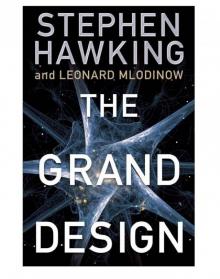 The Grand Design
The Grand Design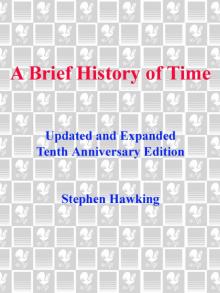 A Brief History of Time
A Brief History of Time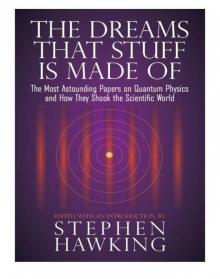 The Dreams That Stuff is Made of
The Dreams That Stuff is Made of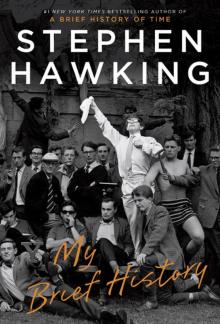 My Brief History
My Brief History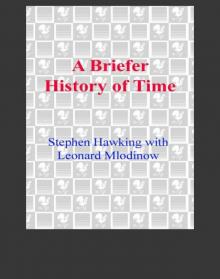 A Briefer History of Time
A Briefer History of Time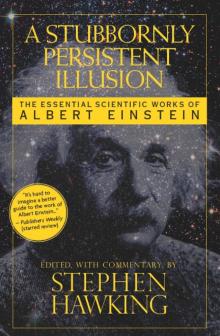 A Stubbornly Persistent Illusion
A Stubbornly Persistent Illusion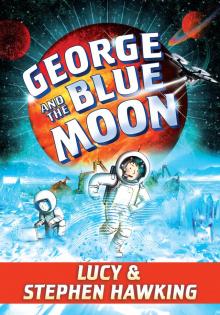 George and the Blue Moon
George and the Blue Moon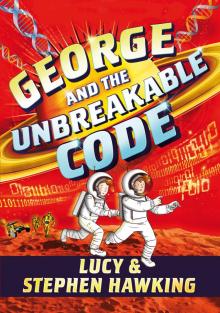 George and the Unbreakable Code
George and the Unbreakable Code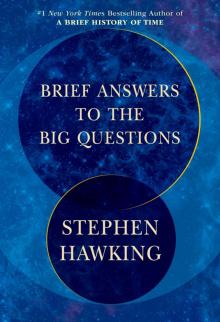 Brief Answers to the Big Questions
Brief Answers to the Big Questions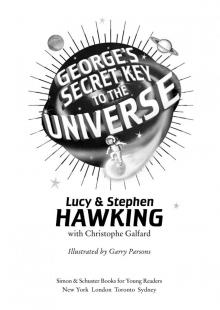 George's Secret Key to the Universe
George's Secret Key to the Universe